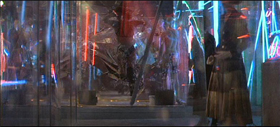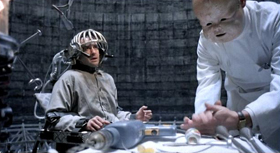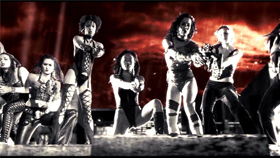


the unavoidable
Films like Bladerunner and Brazil produce dystopia through the institutionalization
of violence by the ‘Establishment’.
In Bladerunner violence is brought to the public realm through the assignment
given to the protagonist by the police. Deckard is justified in opening
fire in a crowded street and indirectly causing massive damage to public property
in the name of establishment institutionalized violence. While the public still
has respect for contemporary social mores, including a disapproval of violence,
the actions of the Establishment have led to violence in the public realm against
which the actions of the individual are ineffective. The individual is left
vulnerable to the random outbursts of violence perpetuated by the system.
Brazil uses two types of violence. One is the series of random public attacks led by rebels against the government which results in eruptions of violence that inevitably result in civilian casualty. Again, the involvement of the public is random and arbitrary as part of rebel measures against a repressive government. Simultaneously the government hunts the rebels by capturing suspects and subjecting them to interrogation by torture, a form of silent institutionalized violence which the general public is unaware of and constantly in danger of being subjected to. Responsibility
for the choosing the subjects and performance of the torture are separated
by miles of paperwork, meaning that baseless suspicion is suddenly grounds
for the abduction and torture of innocent citizens.
In Brazil and Bladerunner, violence enters the
public realm through the direction of government or rebel organizations; where
direction and perpetration are separated by paperwork and officially condoned
violence runs rampant in the streets.
In Frank Miller’s SinCity violence in the public realm becomes
unavoidable because, well, everybody’s violent. If our system of social mores degenerates to the point where taking an eye for and eye is the only way to protect yourself – everyone
begins trying to pull each others eyes out, and your safety depends on how good
you are at taking eyes. Again, violence in the public realm becomes sanctioned,
though in Sin City it is though unofficial public agreement rather than institutional
machination.
Finally Akira takes sanctioned violence to a new level, through the fate-ordained apocalypse of Neo-Tokyo. Where the individual in the dystopic city has no protection from violence, the city in the dystopic future is just as vulnerable to uninitiated destruction.
In the dystopia of the unavoidable, the individual is cast as the hapless accidental target of violence misdirected or arbitrary; safety is only assured by the peaceful withdrawal from all forms of society.